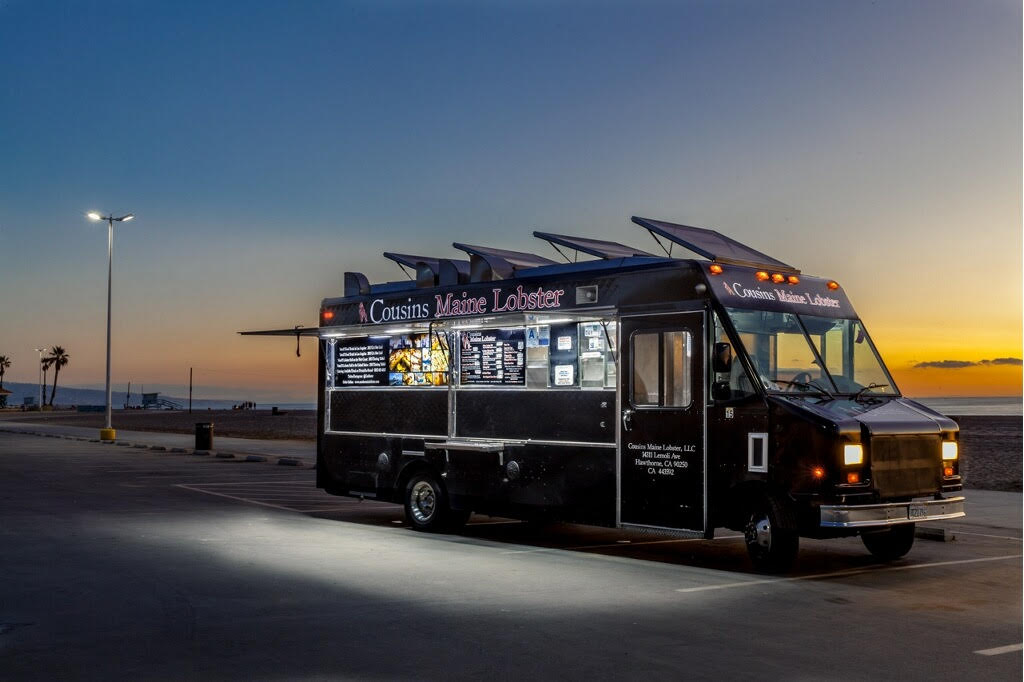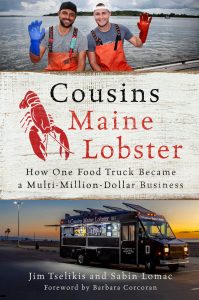How The Cousins Maine Lobster Food Truck Is Taking A Classic New England Dish Around The Country
Sabin Lomac and Jim Tselikis are no strangers to the Maine lobster bake. They grew up in Maine, and, although they have since moved away, their childhood memories of simple, homemade lobster rolls inspired them to start a business: Cousins Maine Lobster. It all started as a food truck, that served, you guessed it, Maine lobster. Since they opened their first truck out in L.A., they have expanded to over a dozen cities, including Portland, Maine with a truck that will open in Southern Connecticut in the early fall. But it’s not just food trucks–the duo have also opened restaurants, and they put their incredible success story in their new book, Cousins Maine Lobster: How One Food Truck Became a Multi-Million-Dollar Business. John Dankosky spoke with Sabin Lomac about how his childhood in Maine with Tselikis inspired their career.
Interview Highlights
These excerpts have been lightly edited for length and clarity.
John Dankosky: You write that the goal is to sell Maine lobster in the Maine way. What is the Maine way to you?
Sabin Lomac: The Maine way is tradition, the best food, the best lobster in the world, being kind to the people who frequent your business, being kind, being a genuine person. […] It doesn’t need to be fancy but it does need to be good. You need to feel valued and appreciated.
You describe the Maine lobster roll as something that’s like the Thanksgiving turkey sandwich. What do you mean by that?
Growing up, lobster bakes were boiling pots of lobster and corn and potatoes and salad and beer. And what was happening is there was a lot of leftover lobster. And the lobster roll kind of originated when you had leftover lobster, you never throw out lobster. So you’d get these funky New England lobster rolls, and you put in your lobster that’s leftover, some people added mayonnaise, some people added chives or lettuce. So just like Thanksgiving dinner, you have leftovers. [..] It’s a tradition to us. And we wanted to replicate that.
We broadcast to listeners all over New England and there’s a lot of similarities between the states but a lot of differences in the region. And one of those is that in Maine, as you suggested, that lobster roll that comes after the lobster bake has mayo, maybe some scallions, but in Connecticut and some other parts we make sure it gets into butter and it’s a different experience, a warm lobster roll. Can you talk about the divide?
As you said in Maine the rolls are served chilled, usually with some mayonnaise and it’s very simple. Two weeks before opened our business, Jimmy, my cousin, called me and said there was a thing called the Connecticut lobster roll. I said let’s put it on the menu, we’ll keep it on for two weeks, if it doesn’t sell we’ll take it off. And we are six years into the business, we have over 40 locations–and it is definitively–the Connecticut roll is our best seller at every location.
Excerpt From Cousins Maine Lobster: How One Food Truck Became a Multi-Million-Dollar Business.
“So where did our lives intersect? It was mostly during family gatherings—birthdays, holidays, the usual moments when all our nutty relatives got together. We weren’t the only cousins in the bunch, but we formed a friendship as kids that we now realize went deeper than most cousin friendships. We certainly liked the same things, and established a bond playing NHL ’94—a very popular hockey video game at the time. But it would be the family gatherings at Jim’s house in Cape Elizabeth that would create the intimate bond that would one day build a company.
In Maine, the summer lobster bake is so normal and common that it’s part of the rhythm of life there. It’s just what families do when they get together in those few precious months when the weather is perfect—and Maine summers are perfect. The scene is simple but beautiful: The family would gather at the Tselikis’s, a total of five cousins, several aunts and uncles, and grandparents. Steve would get the water boiling, which isn’t just for lobster, but also clams and corn. The aroma would permeate the backyard, while the sound of kids playing and laughing was a steady drum in the background. The adults would sip their beer, wine, and cocktails, and we kids rough- housed until we were sweaty and dirty. Then the food would be brought out onto large picnic tables, spread out over old newspapers, and that’s when we’d dive in. Of course, there would be leftovers, which is where the lobster roll comes in. Much like that the old standby, the turkey sandwich, which is the perfect leftover meal after Thanksgiving, the lobster roll is the best way to enjoy lobster after a bake.
As we said, this scene isn’t at all unique to our family. It’s a scene that plays out every summer day in Maine—and any Mainer would recognize that gathering in Jim’s backyard. Like a lot of childhood memories, the lobster bakes are ingrained in our hearts as pristine, almost idyllic. And as we grew older and took on our own struggles, challenges, and worries, the ghosts of Jim’s backyard seemed to call to us, reminding us of the way life should be. We still gather there when we can, but, of course, it’s different. Those same grandparents who would chase us, hug us, and teach us how to pick a lobster clean are now gone. The parents, aunts, and uncles who used to haul the bags of live lobster, the cases of beer, and the ice now prefer to rest with a drink while the younger generation does the heavy lifting. The laughter and squeals of us kids have become the mature banter of grown adults—well, maybe “mature” is too strong a word. We appreciate those precious hours all the more now, all of us together again, even as we mourn the passing of those carefree summer days of our childhood, when nothing mattered more than showing our grandfather how fast, strong, or tough we were.
The college years found Jim at the College of the Holy Cross in Worcester, Massachusetts, where he played Division I hockey, while Sabin let his acting bug take him to Hofstra University on Long Island to study drama. After graduation, Jim stayed in the Boston area and eventually got into medical sales for Stryker Corporation. Meanwhile, Sabin hung around New York City, landing the occasional acting role, but also earned his real estate license to make ends meet. It wasn’t long before acting took Sabin to Los Angeles, as it usually does for actors. Jim vaguely remembers hearing that Sabin had “moved away”— which means away from New England—but he wasn’t there to see his cousin off. We had gone our separate ways.
Our jobs after college certainly taught us some necessary skills for starting and growing our own business, but we’ll get to those lessons later. What’s important is at this stage in our lives is that after we left college—well, Jim graduated a couple years before Sabin—we slowly lost contact with each other. The gatherings in Jim’s backyard became less frequent, our connection to Maine more tenuous. That seemed normal to us, as it must for most. You grow up to leave home behind and build your own future. The absolute last thought in either of our heads was to take what we had known as children and re-create it.
And then, years later, out of nowhere Jim called Sabin.”
Copyright © 2018 by the authors and reprinted with permission of St. Martin’s Press, LLC.



